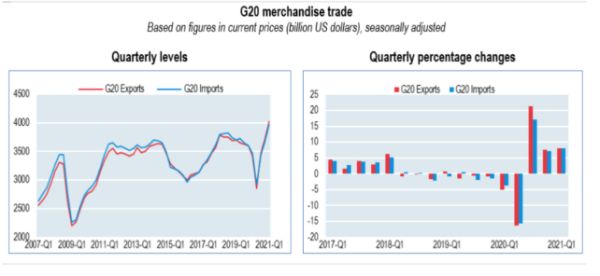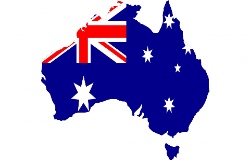G20 Merchandise Trade Reaches Record High In First Quarter Of 2021
Continuing the recovery initiated in the third quarter of 2020, international merchandise trade for the G20 reached record levels in Q1 2021, as measured in seasonally adjusted current US dollars. Compared with the previous quarter, exports and imports increased by 8.0% and 8.1%, respectively.
With the exception of the United Kingdom, all G20 economies recorded positive growth in Q1 2021, with the depreciation of the US dollar and the related increases in commodity prices playing a role in the recovery from the COVID19 lows.
Prices of agricultural commodities, including cereals and vegetable oils, increased by over 10% in Q1 2021, while prices of metals are close to levels last observed in 2011. Argentina (exports up 33.3%), Australia (exports up 17.5%), Brazil (exports up 14.7%), and South Africa (exports up 17.3%), among the G20’s largest exporters of those products, have benefitted from the rising commodity prices.
Additionally, the nearly 35% increase in crude oil prices in Q1 2021 translated into the rising export values of Canada (up 10.8%), Russia (up 13.1%), and Indonesia (up 12.4%). Since energy products are a major import for most G20 economies, the price increases also resulted in higher import values in the same period.
Finally, the pandemic-related boom in purchases of electronics led to a surge in demand for semiconductors and integrated circuits. Along with several other factors, this led to supply failing to keep pace with demand, resulting in shortages and price rises. While higher trade in semiconductors partly contributed to total merchandise trade growth in the United States (exports and imports up by 5.7% and 5.3%, respectively), chip shortages affected, in particular, the automotive supply chains. A slowdown in shipments of vehicles and parts weighed on total merchandise exports from France (up 2.7%) and Mexico (up 0.4%), both markedly below the G20 average.
China, the G20’s largest merchandise trader, saw exports (up 18.9%) and imports (up 19.0%) soar in the first quarter of 2021. Chinese import growth was led by metals and metal ores, cereals and integrated circuits, while export growth was led by electronic products including integrated circuits, vehicles, and textiles (including face masks). In the European Union exports and imports grew by 3.8% and 5.0%, respectively.
The United Kingdom was the only G20 economy to record negative merchandise trade growth, both for exports (minus 5.7%) and for imports (minus 10.5%) in Q1 2021. The slowdown follows large increases in the previous quarter, when stockpiling was taking place in view of the exit from the EU Single Market.
See the full release.
See the tables and charts in Excel.

Source: OECD Statistics and Data Directorate. Visit the interactive OECD Data Portal to explore these data further.


 SNAP: Survivors Deliver Vos Estis Lux Mundi Complaints Against Six Cardinals To Vatican Secretary Of State Parolin
SNAP: Survivors Deliver Vos Estis Lux Mundi Complaints Against Six Cardinals To Vatican Secretary Of State Parolin UNICEF Aotearoa NZ: Myanmar Earthquake A Further Blow For Millions Of Children
UNICEF Aotearoa NZ: Myanmar Earthquake A Further Blow For Millions Of Children Greenpeace: 'Desperate And Deceitful'- Deep Sea Mining Frontrunner Turns Its Back On Pacific Nations
Greenpeace: 'Desperate And Deceitful'- Deep Sea Mining Frontrunner Turns Its Back On Pacific Nations 350.org: Australia Announces Election Dates, Pacific Islanders Rally To Vote For Climate
350.org: Australia Announces Election Dates, Pacific Islanders Rally To Vote For Climate UNICEF Aotearoa NZ: Global Aid Funding Cuts - 14 Million Children At Increased Risk Of Severe Malnutrition And Death
UNICEF Aotearoa NZ: Global Aid Funding Cuts - 14 Million Children At Increased Risk Of Severe Malnutrition And Death Oxfam Aotearoa: Humanitarian Operations In Gaza Severely Hampered; Famine Risks Increasing
Oxfam Aotearoa: Humanitarian Operations In Gaza Severely Hampered; Famine Risks Increasing